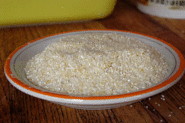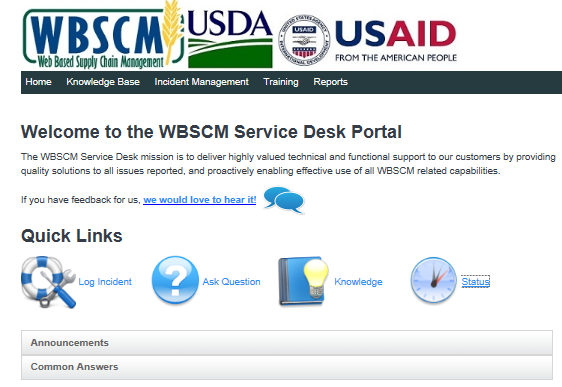|
{Featured in the Augusta Free Press in May; photo courtesy of FeedMore}
FeedMore recently held the first Commodity Supplemental Food Program (CSFP) distribution in the state of Virginia. A food assistance program that is focused on low-income seniors at least 60 years of age who are at risk of malnutrition, CSFP provides these individuals with wholesome food while helping them stretch their food budget.
Working in partnership with the Virginia Department of Agriculture and Consumer Services (VDACS), FeedMore distributed the CSFP boxes to approximately 30 seniors at the Sycamore Towers in Petersburg. With the supplemental food boxes including a variety of nutritious food items including canned salmon, peanut butter, oatmeal, canned fruits and vegetables and cereal the recipients also received educational materials with nutritional information and recipes. Read more
The lovely lady in red received the first two CSFP boxes in the Commonwealth of Virginia.
Innovative Pilot Project Aims to Increase Participation in CSFP in Rhode Island
A recent pilot outreach project formed a partnership between CSFP and SNAP, or the Supplemental Nutrition Assistance Program, at the State level. The Rhode Island Department of Human Services (RI DHS) Division of Elderly Affairs initiated a joint CSFP and SNAP outreach pilot with the goal of increasing CSFP participation in the State. The two programs collaborated to identify low-income, senior SNAP participants who may be interested in information about CSFP. RI CSFP then sent an outreach mailing. Twelve hundred eligible SNAP households with seniors ages 60 years and older received an outreach flyer with information about CSFP this June. The outreach initiative will help inform low-income seniors about CSFP. USDA is excited to see what the results of this pilot will be, and if the pilot is successful at increasing CSFP participation, it can serve as a model for similar outreach partnerships in other CSFP States.
 Reminder! Bi-Monthly Issuance of Grits in CSFP
Due to the large package size of grits offered in the CSFP food package, grits should only be issued in the food package every other month, in accordance with the CSFP guide rates. For example, if grits are issued one month, then no other foods in either the “cereals” or “potatoes/grains” category should be issued the following month, because two months-worth of food for one of these categories was already issued in the first month. Please refer to the Food Package Maximum Monthly Distribution Rates for more information or contact your Food and Nutrition Service (FNS) Regional Office with any questions.
|
 We have received inquiries about serving cranberry
juice concentrate, which is offered as a bonus item in The Emergency Food Assistance Program (TEFAP), because the bottle looks like a single-serve, ready-to-drink beverage. Cranberry
juice concentrate should be mixed with water. When prepared with 3 parts water
to 1 part juice concentrate, this product will be similar in flavor and
consistency to cranberry juice. A ½ cup serving of cranberry juice counts as ½ cup in the
MyPlate.gov Fruit Group. For a 2,000-calorie diet, the daily recommendation is
about 2 cups of fruit. Cranberry juice is rich in antioxidants and is also a
great source of vitamin C!
|
Check out these new cookbooks, short
health videos, behavioral economics nutrition education research, and an
infographic on frozen food!
Arizona has created a CSFP Nutrition Education Cookbook (in
English and Spanish) that the CSFP Local Agencies provide
to all participants. These are available in PDF version on the Arizona
CSFP resources webpage. Following the MyPlate categories, the cookbooks provide more than 30 recipes using USDA Foods fruits, vegetables, grains, proteins, and dairy offered through CSFP. For more information, please contact Stacy.Beauregard@azdhs.gov.
Health and Hunger Videos: Great for presentations or audiences, this new 3 minute illustrative video illuminates the intersections of food insecurity, nutrition, and health. The video was developed as a tool to be viewed with communities, advocates, partners, policymakers, volunteers, and others so as to shed light on the cycle of food insecurity and health, and how we can each be part of the solution. A shorter 1 minute video is also available, perfect for sharing on websites and social media platforms. |
|
 |
Nutrition Nudge Research: Cornell University and Feeding America conducted research focused on a behavioral economics nutrition education strategy, known as “nudges,” in a food pantry setting. Nudges are designed to leverage cues in the environment that can influence the decisions individuals make about their food, including encouraging consumers to make healthy food choices. A brief two-page summary of the research is available, in addition to the full report.
TEFAP offers frozen foods, including as bonus items, alongside fresh, canned, and dry options. This infographic highlights how frozen foods can be incorporated into MyPlate goals to create nutritious and affordable meals.
Achieve the Dietary Guidelines for Americans with Frozen
Foods
Why CSFP Inventories Matter
State
Distributing Agencies (SDA) and Recipient Agencies (RA) should practice
effective inventory management to ensure that USDA Foods are distributed in a
timely manner, and in optimal condition. When SDAs over-order USDA Foods
relative to their caseload, it can adversely affect the program. Storage
facilities with high inventories often
stretch limited CSFP resources thin, take product away from other SDAs,
affect product availability at the end of the year, and increase the risk that
USDA Foods may go out of condition before they can be distributed to and used
by participants. Conversely, storage facilities with low inventories increase the risk that an SDA will not have enough
food to meet food package requirements and provide full food packages to participants.
The use of the inventory calculators is not required at the
State level; however, “SDAs
are required to accurately track and maintain the State’ inventory levels of
USDA Foods. While the Food and Nutrition Service (FNS) does not prescribe the
method for States to use, FNS provides the CSFP Inventory Calculator as an optional tool to make this
task easier.” The FNS-152’s are completed by the State and submitted to the
Regions for input into the calculators. The calculator is a Microsoft Excel-based tool which measures inventory levels by food package category. The
calculator comes with instructions
and an instructional
webinar, which are both available on the CSFP
website. The Inventory Calculator combines data submitted by
States with Web-Based Supply Chain Management (WBSCM) food orders to provide an
estimated State inventory level. Recommended inventory levels are 1 to 3 months
by food category. Current federal food distribution regulations prohibit inventory
levels from exceeding 3 months on-hand.
Should your SDA or RA require
additional guidance on effective inventory management, all SDA inquiries should
be directed to the appropriate Regional Office. All Local CSFP Agencies
should contact their SDA for any program assistance or to provide customer
feedback about any USDA Foods product.
Do
you need State-specific information on the Commodity Supplemental Food Program
(CSFP)? CSFP Contacts
Are
you interested in specific information on storage and inventory management of
USDA Donated Foods? Review Food Distribution National
Policy Memorandum FD-107.
The
Complaint Team is available Monday-Friday, 6:00 a.m. – 5:00 p.m. Eastern Time.
Email USDAFoodsComplaints@fns.usda.gov or call the USDA Foods Complaint
Hotline at 800-446-6991.
|
Transitioning from “As Is” to “To Be” for Business Management Improvement
The Business Management Improvement (BMI) project has completed the “As Is” phase. Through workshops, playback sessions, and interviews, the Domestic team captured the current end-to-end supply chain process, collected historical and benchmark data, and performed a high-impact cost analysis. Flowcharts and narratives for the six process areas (below) are available on the BMI website under the “As Is” section:
The “To Be” phase focuses on the future. USDA and stakeholders collaborated in a series of workshops in June and July to design improved business processes and to identify related policy, procedures, regulations, and organizational structures. Proposed changes consider the pain points, system gaps, industry references, and benchmarks identified in the “As Is” phase. In August, BMI collaborators participated in a three-day Accelerated Solutions Environment (ASE) workshop to assess solutions, uncover and test assumptions and constraints, and develop implementation steps for new processes in the end-to-end USDA Foods business operations. The final outcome for this phase will be a set of revised flowcharts and narratives for each of the six process areas. The BMI is a significant milestone in the evolution of the USDA Foods program providing stakeholders with an opportunity to share their process improvement ideas. For related news and additional information, visit the BMI webpage. Any questions or comments about the BMI may be directed to CP-BPRINFO@ams.usda.gov.
WBSCM Service Desk Changes
As of May 24, 2016, the email address for the Web-Based Supply Chain Management (WBSCM) Service Desk has changed. All WBSCM users will receive periodic notifications to remind them of the new contact information throughout the next few months. The current contact information is as follows:
Phone: 877-WBSCM-4U (877-927-2648)
Email: WBSCM.servicedesk@CACI.com
Along with this change, WBSCM users now have improved ability to report incidents and track status via an online self-service portal. Users can also search and view historical incidents. A searchable Knowledge Database with answers to common questions is in development.
The WBSCM Service Desk Portal may be accessed at any time (24/7). First time visitors will enter their email address for both the User ID and Password (all lowercase) and will be prompted to create a new password for future access.

USDA Foods were delivered to Focus: Hope Food Center in the 1980s by railroad cars or by truck.
 Here's how to sign up for these updates via GovDelivery:
1. Go to the Food Distribution website.
2. Click on the red envelope on the row of social media icons on the top right of the page.
3. Enter your email address and click "Submit."
4. Check the boxes to select your topics of interest. For these e-letters, scroll down to the Food Distribution category and click the plus sign to the left of the check box to expand the list and view all the sub-categories. Check these sub-categories to receive the corresponding e-letters:
*USDA Foods --> receive all "USDA Foods from Farm to Plate" general + program-specific e-letters
*Commodity Supplemental Food Program (CSFP) --> receive "Household Highlights" e-letter
*The Emergency Food Assistance Program (TEFAP) --> receive "Household Highlights" e-letter
*Food Distribution Program on Indian Reservations (FDPIR) --> receive "FDPIR Connection" e-letter
*Schools/Child Nutrition Commodity Programs --> receive "Spotlight on Schools" e-letter
5. Update your subscription preferences any time by following the above steps or clicking on the Subscriber Preferences Page link at the bottom of any of the e-letter email messages you receive from GovDelivery. Questions? Contact us at USDAFoods@fns.usda.gov
|
|